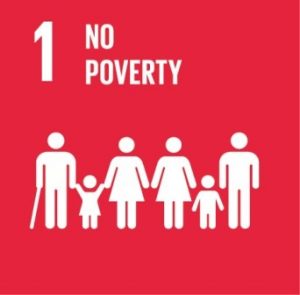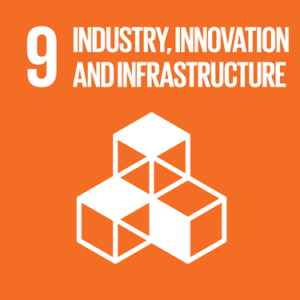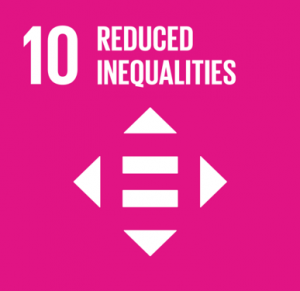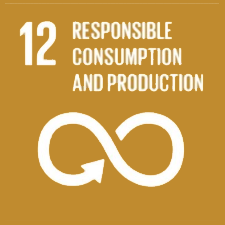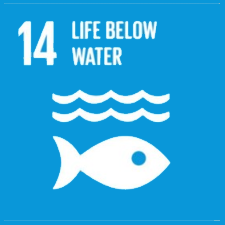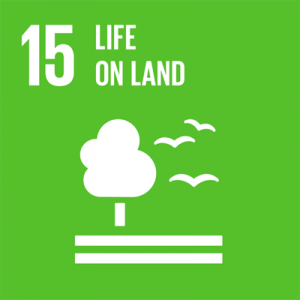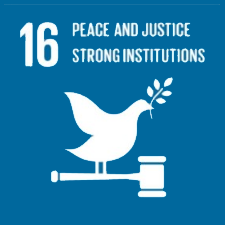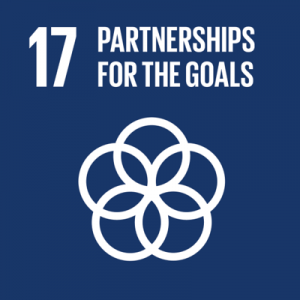SUSTAINABLE DEVELOPMENT GOALS
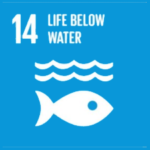
SDG 14: LIFE BELOW WATER
“The two SDGs that look at the broader ecosystem divide it into Life Below Water, and Life on Land. The oceans, and the rivers and watersheds that link to them, are the largest part of our ecosystem. 40% of the world’s population lives within 100km of the coast, and we all rely – directly or indirectly – on the sea.”
(THE Impact Rankings)
Supporting aquatic ecosystems through education
IPB University provides both formal and informal educational programmes on freshwater ecosystems that are accessible to local and national communities, demonstrating its institutional commitment to sustainable water management and conservation. Through its Aquatic Resources Management (ARM/MSP) programme, IPB equips students and practitioners with the ability to apply principles of aquatic resource, environmental, and spatial management based on carrying capacity, conservation, and sustainability. This programme is available at the undergraduate, master’s, and doctoral levels, ensuring comprehensive academic coverage from theory to applied research.
Complementing this, the Water Resource Engineering division focuses on the development and application of engineering knowledge for planning, designing, and managing water resources and related hydraulic structures. Its research scope includes the development and conservation of surface and groundwater sources, springs, rainfall, river basins, and other freshwater systems, as well as the design and management of irrigation, drainage, and water supply networks.
In addition to degree programmes, IPB University also organizes international short courses to enhance knowledge exchange on freshwater and aquatic ecosystem management. One example is the Summer Course Highland to Ocean 2024, titled “Tropical Aquatic Biodiversity and Management from Mountain to the Sea: Emphasis on Blue Carbon,” held on 21–31 July 2024 in Bogor and several coastal field sites. This programme brought together participants from Canada, Madagascar, the Comoros Islands, Timor-Leste, Papua New Guinea, Fiji, the Solomon Islands, and Indonesia, and was taught by experts from leading global institutions, including the University of Oxford (UK), Universiti Sains Malaysia, DAAD Germany, and the Ministry of Marine Affairs and Fisheries of Indonesia, alongside lecturers from IPB’s Department of Aquatic Resource Management.

Figure 1. Participant of The Summer Course Highland to Ocean 2024
IPB University offers educational programmes / outreach for local or national communities on sustainable management of fisheries, aquaculture and tourism.
IPB has several educational programs focused on sustainable management of fisheries, aquaculture and tourism, including:
- Aquaculture Technology and Management
This study program provides mastery of the science, technology, and management of aquaculture (freshwater, brackish, and marine), covering fish, aquatic plants, and other aquatic organisms (aquatic biota) with an environmentally friendly and sustainable approach.
- Capture Fisheries Technology and Management
This study program has the mandate to develop the capture fisheries sector, particularly in the management and utilization of Indonesia’s marine and fisheries biological resources. It focuses on mastery of sustainable capture fisheries science and technology, including fishing gear, fisheries resource exploitation technology, fisheries vessels and transportation, capture fisheries policy, capture fisheries management, and fisheries port management.
- Marine Science and Technology
This program has a mandate in the development of marine science and technology for the sustainable exploration of marine resources and the marine environment. Additionally, it aims to understand the characteristics, phenomena, and physical, chemical, biological, and geological processes of the ocean by utilizing remote sensing and marine acoustics.
During 2024, IPB University actively implemented a series of educational and outreach programs for local and national communities that promote the sustainable management of fisheries, aquaculture, and marine tourism.
The Department of Marine Science and Technology organized the School of Coral Restoration (SCORES) Season 3, an online public learning platform that has been running since 2021. SCORES focuses on coral reef restoration efforts in Indonesia and other countries, providing accessible education and training for students, practitioners, and the public to build awareness and technical capacity in marine ecosystem rehabilitation.
Within local communities, Dr. Sri Nuryati Expert IPB through the Community Service Division (Dospulkam), collaborated with the Kediri Fisheries Agency to enhance the productivity and sustainability of catfish farming. The program offered training and technical assistance for local fish farmers, emphasizing environmentally friendly practices, efficient feed utilization, and improved water quality management.

In addition, IPB partnered with the provincial government to develop mangrove crab aquaculture using the sylvofishery method—an innovative system that integrates mangrove conservation with aquaculture production. This approach supported both sustainable livelihoods for coastal communities and the preservation of vital mangrove ecosystems in Central Kalimantan.
Furthermore, Dr. Beginer Subhan, an expert from IPB University through Dospulkam, introduced coral microfragmentation technology to the Smiling Coral Indonesia community as an innovative method to accelerate coral reef rehabilitation. Conducted on Pramuka Island, Seribu Islands, this program trained local participants in coral propagation, reef monitoring, and sustainable marine ecosystem management.

Moreover, a team of lecturers from the Department of Fisheries Resource Utilization (PSP), Faculty of Fisheries and Marine Sciences (FPIK) – IPB University, consisting of Yopi Novita, Wazir Mawardi, Sugeng H. Wisudo, Budhi H. Iskandar, Vita R. Kurniawati, and Dwi Putra Yuwandana, conducted a training program for fishers in Kampung Muara 2, Cikiruhwetan Village, Cikeusik District, Pandeglang Regency, Banten. The activity took place at the Cikeusik Fish Auction Hall (TPI) on Wednesday, August 7, 2024. The training covered several topics. The first focused on the operation of environmentally friendly fishing gear, aimed at raising fishers’ awareness to use and operate gear that does not damage fish resources or the environment, thereby ensuring the sustainability of fish stocks. The second topic addressed fisheries business management, with the hope of empowering fishers to become centers of economic growth in coastal areas. Lastly, the session on risk mitigation efforts was delivered to support Occupational Health and Safety (OHS), considering that the fishing grounds of the Cikiruhwetan fishers are located in the Indian Ocean.
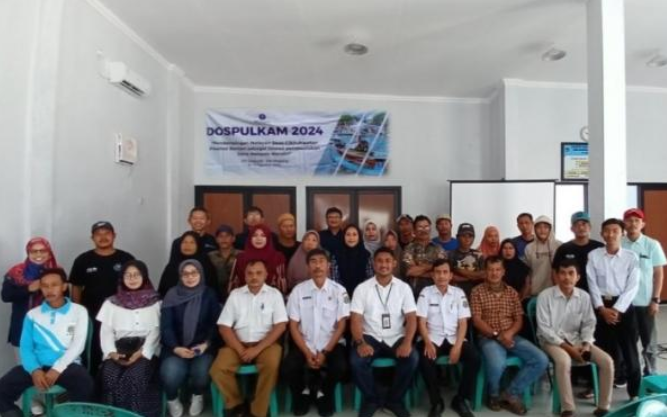
At the national community level, IPB University strengthened education and capacity building in sustainable aquaculture technology. Its faculty members conducted training for vocational school teachers across Indonesia on the Recirculating Aquaculture System (RAS)—a modern fish farming technology designed to minimize water use and environmental impacts. This initiative enhanced the quality of vocational education and promoted the adoption of sustainable aquaculture practices among future generations.
In addition, the Center for Coastal and Marine Resources Studies (CCMRS) collaborated in organizing a national webinar titled “Sustainable Fishing Strategies for Fisher Welfare”, which served as a platform to share knowledge on responsible fishing, ecosystem protection, and sustainable management strategies to ensure long-term prosperity for fishers.
Furthermore, PKSPL IPB, in collaboration with the Directorate General of Marine and Fisheries Resources Surveillance, Indonesian Ministry of Marine Affairs and Fisheries (PSDKP–KKP), conducted the Training on Coastal and Marine Ecosystem Services (CMES) Assessment and Valuation to strengthen the capacity of government officials, researchers, and practitioners in evaluating the economic value of marine and coastal ecosystems. The program emphasized evidence-based decision-making for sustainable fisheries and marine tourism planning. Moreover, PKSPL IPB, in partnership with PT Biro Klasifikasi Indonesia (PT BKI), organized a five-day Blue Carbon Accounting Training from 29 July to 2 August 2024. The training aimed to improve participants’ knowledge and skills in quantifying and managing blue carbon as a key component of climate change mitigation. Attended by 15 staff members from various divisions of PT BKI, the program combined classroom learning in North Jakarta with field sessions on Pari Island, Thousand Islands, where participants conducted direct measurements and analyses of blue carbon in coastal ecosystems, including mangroves and seagrasses.
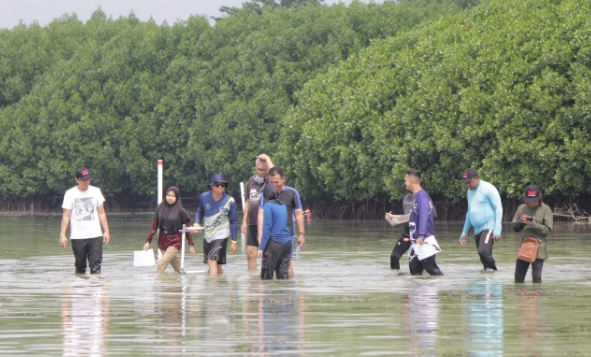
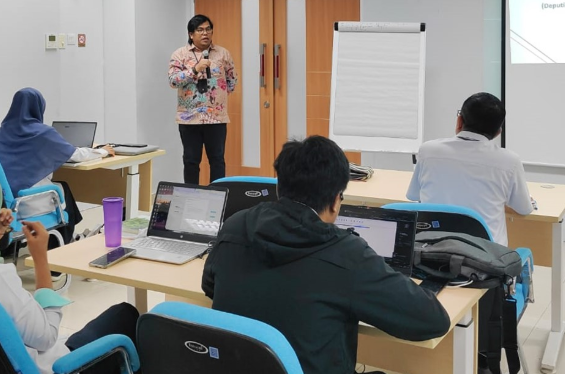
In 2024, IPB University offer educational outreach activities for local and national communities to raise awareness about overfishing, illegal, unreported and unregulated fishing and destructive fishing practices, including :
- IPB University experts provided education outreach to the national community on maritime security in the Nusantara Capital (IKN) Region
IPB University, in collaboration with Indonesian Maritime Security Agency on maritime security in the Nusantara Capital (IKN) Region. Dr. Solihin, an expert IPB University provided educational activities to strengthen maritime safety and surveillance in the Archipelagic Sea Lane II and the marine areas surrounding the Nusantara Capital (IKN). Through expert participation from IPB’s Faculty of Fisheries and Marine Sciences, this initiative emphasized public education on maritime law enforcement, monitoring of illegal fishing activities, and the importance of inter-agency coordination to prevent IUU fishing in Indonesian waters. This activity was carried out on December 5, 2024.
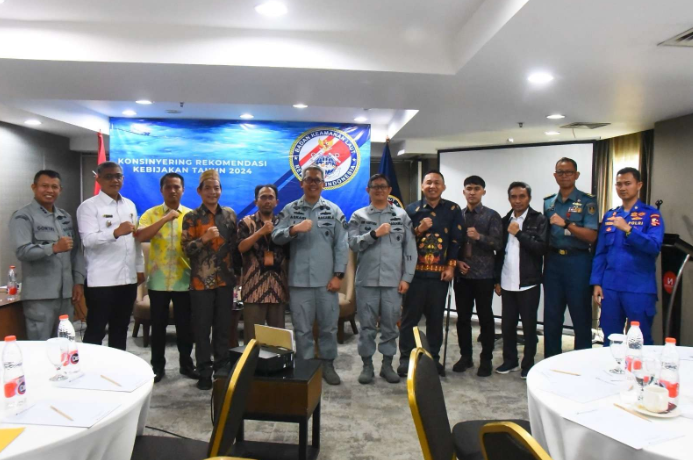
- IPB University leads community outreach on illegal fishing
In collaboration with media and academic experts, Dr. Akhmad Solihin contributed to a national dialogue on illegal fishing following Indonesia’s adoption of the Port State Measures Agreement (PSMA). This discussion raised public awareness of persistent challenges in combating IUU fishing despite policy enforcement, highlighting the need for stronger data transparency, technological monitoring, and community-based surveillance. IPB’s commitment to promoting education on the impacts of overfishing and illegal practices on marine ecosystems and livelihoods.
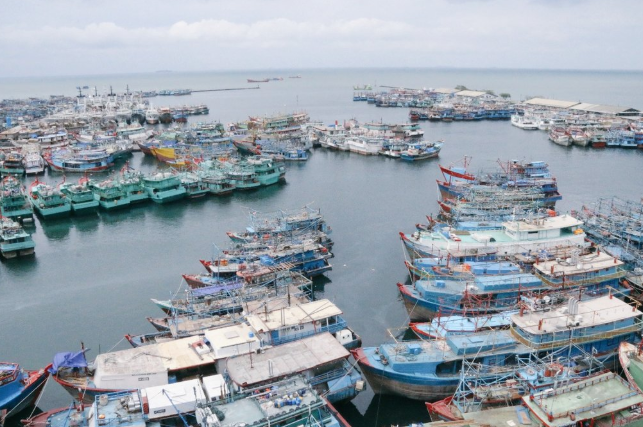
- Center for Coastal and Marine Resources Studies organized The 19th World Islands Conference (WIC)
IPB University, through its Center for Coastal and Marine Resources Studies (CCMRS), hosted the 19th World Islands Conference (WIC) in collaboration with the International Small Islands Alliance (ISIA), the Archipelagic and Island States (AIS) Forum, and the University of Mataram. The conference served as an international educational platform to share knowledge on sustainable island management, marine conservation, and the prevention of destructive and illegal fishing practices. It engaged participants from academia, government, and local island communities to discuss policy innovation, marine biodiversity protection, and strategies for sustainable small-island fisheries management.

- Basic safety and responsible fisheries training
IPB University through Department of Fisheries Resources Utilization conducted a Basic Safety Training for Fisheries at Pelabuhan Perikanan Nusantara (PPN) Kejawanan Cirebon on 2 February 2024. This Training aimed at improving the knowledge and preparedness of fishers, particularly in relation to sustainable and responsible fishing operations. The training introduced participants to safety-at-sea protocols, environmentally friendly fishing methods, and regulatory compliance to prevent IUU fishing and minimize destructive practices. It also built local capacity to recognize and report illegal fishing activities. The training was attended by 130 fishers based at the port, who work as crew members (Anak Buah Kapal or ABK) on fishing vessels with a capacity of more than 30 Gross Tonnage (GT).

5. IPB University’s global representation on sustainable fisheries management
Prof. Indrajaya, a professor from IPB University, attended the 9th World Fisheries Congress (WFC) held in Seattle, United States, on April 4, 2024. On this occasion, he presented Indonesia’s fisheries management strategies to an international audience. His presentation highlighted evidence-based policymaking, community participation in surveillance, and strategies to reduce overfishing and combat illegal fishing.
The congress also served as a platform for participants to gain a deeper understanding of the challenges and opportunities in fisheries management across different countries and regions. By focusing on effective and sustainable governance, the WFC provided a forum for stakeholders to build networks, establish partnerships, and formulate concrete actions toward more sustainable and resilient fisheries. Moreover, the 9th World Fisheries Congress stood as a significant platform for advancing global progress in fisheries science, industry, and policy toward greater sustainability.

Supporting aquatic ecosystems through action
IPB University has a faculty and two research centers focused on activities related to the conservation and sustainability of Marine and aquatic ecosystems. To support conservation and promote sustainable use, IPB University has organized numerous events in partnership with various collaborators. In 2024, IPB held several events in collaboration with a diverse range of stakeholders, including industry, universities, local community organizations, etc. These events included:
- Center for Coastal and Marine Resource Studies (CCRMS) and Pokmaswas Reng Paseser co-organise mangrove conservation events for extreme coasts
In August 2024, the Center for Coastal and Marine Resource Studies (CCRMS) IPB University together with the community-based monitoring a community group Pokmaswas Reng Paseser trialed a new mangrove-planting method named Si Tampan (Sistem Tanam Pancang Berumpun) on the coast of Pantai Kundang Wetan, Desa Tanjung, Saronggi, Sumenep. They planted 560 seedlings of a mangrove Rhizophora stylosa using a clustered pile-planting technique designed for extreme coastal conditions with strong wave action and poor nutrient substrates. The method is intended to trap more sediment and nutrients and act as a natural wave break, enhancing mangrove survival and ecosystem services. The initiative was part of IPB’s “Dosen Pulang Kampung” outreach programme and involved local villagers, school staff and Pokmaswas volunteers. Community enthusiasm was high, as the clustered planting proved more vigorous than previous one-by-one methods.

- School of Coral Reef Restoration (SCORES)
The Department of Marine Science and Technology (ITK) of IPB University has organized an educational program called the School of Coral Reef Restoration (SCORES), supported by WWF, which has been running for three years since 2021. This program educates participants on coral reef restoration through transplantation techniques. As part of the initiative, the department held a webinar titled “Key to Successful Coral Reef Restoration: The Importance of Maintenance and Monitoring” on December 28, 2024. The event featured practitioners from the LivingSeas Foundation, who shared practical methods such as using bottles as substrates and constructing large “Super Star” structures for coral transplantation. They also emphasized the importance of systematic monitoring every six months, consistent maintenance efforts, and the integration of tourism-based participation to ensure long-term sustainability.
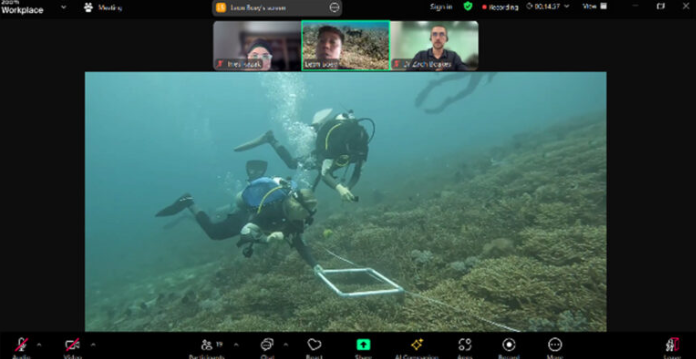
- IPB University co-organises partnership event on sustainable marine tourism and conservation
In April 2024, IPB University through the Center for Coastal and Marine Resource Studies (CCRMS) facilitated the signing of a partnership agreement for the sustainable development of the marine tourism and conservation area, Taman Wisata Perairan (TWP) Gili Balu, in West Sumbawa, West Nusa Tenggara. The agreement was signed between the Regional Public Service Agency of the Technical Implementation Unit for the Marine and Fisheries Resource Management Agency of the Sumbawa–West Sumbawa Region, as the manager of TWP Gili Balu, and the community tourism group of Poto Tano Village. This five-year collaboration, supported by CCRMS IPB University, includes the deployment of two field staff to facilitate stakeholder communication, promote ecosystem-based tourism, and strengthen conservation governance. This initiative highlights IPB University’s active role in supporting and organizing programs and partnerships that promote the conservation and sustainable utilization of marine resources.
During 2024, IPB University implemented the following student-led conservation initiatives:
- The Forest Resource Conservation Student Association contributes to promoting the conservation in IPB Campus
The Forest Resource Conservation Student Association consistently engages in various environmental preservation activities. They regularly conduct biodiversity monitoring, including observations of plants, mammals, birds, amphibians, reptiles, and various butterfly species. In addition, to inspire the younger generation to develop a love for nature conservation, the association actively participates in various campaigns and social media activities featuring engaging content such as photography competitions and quizzes. They are also actively involved in providing environmental education for early childhood students.
- IPB University Supports Coastal Conservation Efforts: KKNT Inovasi and Community Plant 500 Mangroves in Indramayu
IPB University’s KKNT Inovasi students organized a mangrove-planting event on 10 September 2024 in Desa Pabean Ilir, Pasekan, Indramayu. Together with the local Kelompok Pecinta Mangrove community, they planted 500 mangrove seedlings. The activity also served as public outreach, highlighting the role of mangroves in buffering storms and waves and in providing nursery habitat and food for fish, shrimp, and crabs—thereby protecting coastlines and supporting fisheries. The event concluded with the handover of additional seedlings to the community to ensure continued care and maintenance.

- “KONSURV 2024”
The KONSURV 2024 monitoring team consisting of members of the Marine Science and Technology Student Association (Himiteka) of IPB University conducted the first monitoring of the mangrove planting initiative in Mundu Village, Cirebon, West Java. This monitoring aims to assess the success of the planting and the influence of conservation actions carried out on July 2024.
From the monitoring results, 763 mangrove seedlings were found dead, most of which were caused by natural events such as drowning and large waves. To address this, the monitoring team replanted 200 seedlings with a planting strategy of one stake for two propagules, and a further 113 seedlings will be planted the following day with the help of a crew from Mundu Village. In addition, trash, especially bamboo fragments, was seen piling up at the mouths of other rivers, affecting the environmental conditions of Mundu Village.
IPB University is strongly committed to ensuring that all food served on campus is supplied from sustainably managed aquatic ecosystems and harvested responsibly, as mandated in the Circular Letter No. 24714/IT3/HM/M/B/2021 concerning Healthy and Sustainable Lifestyle in IPB University. This commitment, particularly outlined in Point 5 (page 4), emphasizes maintaining the quality and ethical sourcing of food. All university agencies, as well as contracted and subcontracted services, are required to :
- provide local and or community-based products and healthy and nutritional foods.
- maintain food health and hygiene, environmental hygiene, and the beauty, order, and preservation of garden facilities and public facilities in the environment around the Canteen
- Assess and monitor the ethics behind the seafood the University serve and telling the University suppliers to remove endangered species from menus and catering
- maintain the canteen environment by paying attention to the level of hygiene, cleanliness, health, and halal of food
- maintain the quality of food and the cleanliness of utensils and equipment used in providing food
- comply with and implement food quality requirements and minimum service standards
This Circular Letter derives from the Rector’s Regulation No. 133/2020 concerning IPB University’s commitment to the implementation of the Sustainable Development Goals (SDGs), particularly Point J (page 2), which reinforces the university’s role in promoting sustainable and ethical food systems.
All university agency organizations and all contracted and subcontracted services shall adhere to these regulations. The requirements herein shall be written into all Requests for Proposals, contracts, sponsorship agreements, and strategic alliance agreements that pertain to procurement of products or services. Any variances shall be approved in writing by the Director of Business, IPB University.
In line with this commitment, the Department of Aquaculture (BDP) under the Faculty of Fisheries and Marine Sciences (FPIK) manages the Babakan Field Station and Experimental Ponds, which consist of 29 ponds of 200 m² each, along with freshwater and marine fish hatcheries. These facilities function as living laboratories for education, research, and innovation in sustainable aquaculture, supporting IPB University’s mission to ensure that aquatic-based food consumed on campus originates from responsibly managed ecosystems.
Furthermore, IPB University strengthens this practice through the Tani Nelayan Center (TNC)Unit and the Agribusiness and Technology Park (ATP). Tani Nelayan Center is a service hub dedicated to supporting farmers and fishers. It provides a range of services including information dissemination, consultation, training, and technical assistance related to the agriculture, livestock, and fisheries sectors. Through these services, the center aims to empower local producers, enhance their knowledge and skills, and promote sustainable practices across agri-fishery communities. ATP provides certified facilities for sustainable agribusiness, organic production, and environmentally responsible food sourcing under the Indonesian Organic Farming Systems Standard (SNI 6729-2016) including aquaculture standard. Both units play a crucial role in developing and supplying campus food products that comply with sustainability principles and traceability from aquatic and agricultural ecosystems.
In December 2024, the Department of Aquaculture further strengthened this vision through the Visiting Lecture program themed “Committed to Realizing Sustainable Aquaculture”, which highlighted environmentally responsible aquaculture systems, feed management innovations, and technology-based production efficiency improvements.
Moreover every year, IPB University integrates community outreach and applied learning to ensure sustainable aquatic food systems through initiatives like the “Dosen Pulang Kampung” program. In 2024, IPB lecturers carried out various field activities promoting the sustainable and ethical use of aquatic resources. For instance, lecturers from the Vocational School provided environmentally friendly aquaculture assistance to local fish farmers to promote eco-based aquaculture practices.
IPB university works directly to maintain and expand existing ecosystems and their biodiversity, both plants and animals, especially threatened ecosystems.
- The Center for Coastal and Marine Resource Studies (CCRMS) IPB University leads integrated coastal ecosystem restoration in Gili Balu
In 2024, the Center for Coastal and Marine Resources Studies (CCMRS) of IPB University partnered with local stakeholders, the provincial government, and the private sector to implement a series of conservation interventions in the Gili Balu area. The first initiative, “Mangrove Ecosystem Rehabilitation in Gili Balu: Environmental Synergy and Sustainable Tourism,” marked the beginning of a mangrove restoration effort through a collaborative approach involving communities, academia, and industry. This program integrates ecosystem preservation with the development of sustainable ecotourism.
The second program, “TransformaSea Gili Balu: Integrated Ecosystem-Based Marine Ecotourism Development,” was launched through a partnership between CCMRS, PT Amman Mineral Nusa Tenggara, and the Provincial Government of West Nusa Tenggara. It serves as an integrative platform that not only focuses on planting and protecting marine habitats—such as mangroves, seagrasses, and coral reefs—but also empowers coastal communities through responsible, conservation-based marine tourism.
The third initiative, “Implementation of Coastal Ecosystem Rehabilitation: Seagrass Beds in the Gili Balu Area, West Sumbawa, NTB,” specifically focuses on restoring seagrass meadows as a vital component of shallow marine ecosystems. These habitats function as sediment filters, nursery grounds for juvenile fish, and critical support systems for local fisheries production, while also improving overall coastal ecosystem quality.
Finally, the fourth program, “Coral Reef Ecosystem Rehabilitation in Gili Balu, NTB,” involved a five-day training and mentoring session (1–5 June 2024 in Poto Tano, West Sumbawa) for community surveillance groups (Pokmaswas). Participants were trained in coral species identification, transplantation techniques, and the maintenance of coral restoration media. This activity, conducted in collaboration with The CCMRS IPB University, PT Amman, and the Provincial Marine and Fisheries Agency of West Nusa Tenggara, aimed to strengthen local capacity in preserving and restoring coral reef ecosystem.

Rehabilitation demonstration plot location on Namo Island

Baseline water condition of the seagrass rehabilitation site
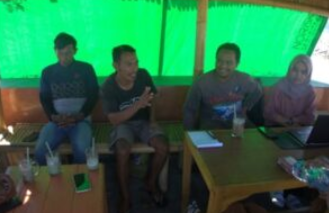
Discussion with the pre-rehabilitation group
2. Collaboration among Center for Environmental Research IPB University, PHE ONWJ, and BKSDA: Strengthening the Pulau Rambut Ecosystem through the “Turtle House” Initiative
An expert team from IPB University’s Center for Environmental Research (PPLH), led by Prof. Hefni Effendi, facilitated a cross-sector collaboration between Pertamina Hulu Energi – Offshore North West Java (PHE ONWJ) and the Jakarta Natural Resources Conservation Agency (BKSDA Jakarta) to establish a “Rumah Penyu” (Turtle House) on Pulau Rambut, Kepulauan Seribu. The activity took place on 4 December 2024. The team implemented concrete biodiversity protection measures, including designing conservation education infographics (covering species biology, nesting cycles, and visitor guidelines) and installing an IoT-based, solar-powered CCTV system to monitor landings and nesting of the critically endangered hawksbill turtle (IUCN status: Critically Endangered). The site, which is both a Ramsar wetland and a designated wildlife sanctuary, was officially launched with stakeholders and included hatchling releases, supported by documented outcomes from 2018–2022 such as rescued nests, protected eggs, and released hatchlings.

In 2024, IPB University collaborated with various industry leaders to advance technology and sustainable practices in the marine sector, focusing on reducing environmental impacts on aquatic ecosystems follows several activities :
- IPB University introduces eFAD (electronic Fish Aggregating Device) technology for fishermen on Sebesi Island
In July 2024, lecturers and students from the Department of Fisheries Resource Utilization, IPB University, introduced an eFAD (electronic Fish Aggregating Device) technology for small-scale fishers on Sebesi Island, Lampung. The initiative was in collaboration with PT Indocarbon Nusantara, the Directorate for Agromaritime Community Development (DPMA), the Tani dan Nelayan Center (TNC), the Indonesian Fisheries Scholars Association (Ispikani), and the Sebesi Island Marine Protection Management Board (BPDPL). The activity was attended by the village head, BPDPL representatives, and 20 local fishers engaged in handline, lobster net, and trap fishing.
Dr. Roza Yusfiandayani, as the lead innovator, explained that the eFAD (electronic Fish Aggregating Device) was designed as a portable rumpon-like device, featuring a compact and waterproof casing that is energy-efficient, lightweight, and easy to use in various fishing conditions. Unlike conventional fish-attracting lights that rely on diesel generators, this innovation aims to employ rechargeable power sources and future solar-energy integration, thereby reducing fuel consumption, operational costs, and carbon emissions in small-scale fisheries.

- IPB University collaborated with Regal Springs Indonesia to advance “blue food” and promote integrated, responsible tilapia aquaculture
IPB University, through the Faculty of Fisheries and Marine Sciences (FPIK), signed a master cooperation agreement with Regal Springs Indonesia on 14 June 2024 at the Sumardi Sastrakusumah Auditorium, IPB Dramaga Campus. The partnership aims to advance “blue food” and promote integrated, responsible tilapia aquaculture. It also encompasses human resource development, knowledge and technology transfer, and integrated aquaculture practices designed to improve nutrition outcomes while aligning operations with recognized sustainable aquaculture standards.
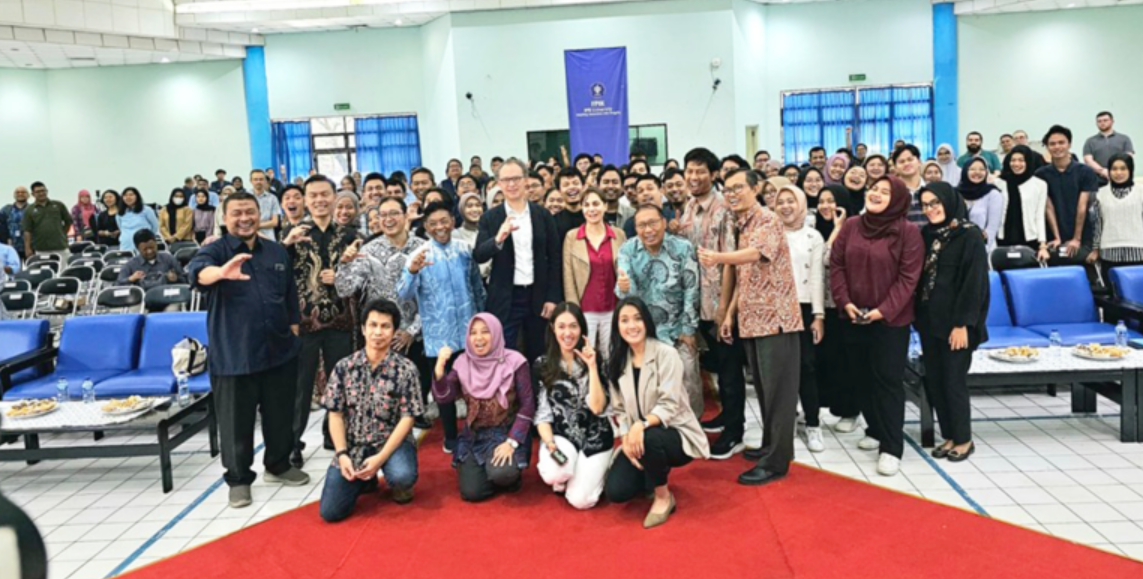
- Grouper breeding innovation based on pond rebon resources in Cangkring Village
A team of lecturers from the Department of Aquaculture at IPB University—comprising Dr. Yani Hadiroseyani, Dr. Irzal Effendi, Dr. Tatag Budiardi, Prof. Iis Diatin, Dr. Apriana Vinasyiam, Dr. Kukuh Nirmala, and Belinda Astari, S.Pi., M.Si.—conducted a training and pilot project on grouper nursery innovation based on the use of pond shrimp (rebon) resources in Cangkring Village, Cantigi District, Indramayu Regency, West Java. This innovation utilizes the abundant local rebon shrimp found in estuaries and ponds as a high-quality natural feed for grouper fry, replacing dependence on imported feed or distant raw materials. By integrating locally available resources into aquaculture, this initiative reduces environmental pressure from feed transport and industrial feed production.
The activity involved training around 40 local fish farmers (Pokdakan) and provided comprehensive sessions on estuarine ecology, production systems, business management, and marketing. This program exemplifies how IPB University directly integrates research, technology development, and community empowerment to support sustainable aquaculture practices. By promoting feed innovations that optimize local biodiversity and reduce waste and carbon emissions, IPB university actively contributes to marine industry efforts to minimize environmental degradation and protect aquatic ecosystems.
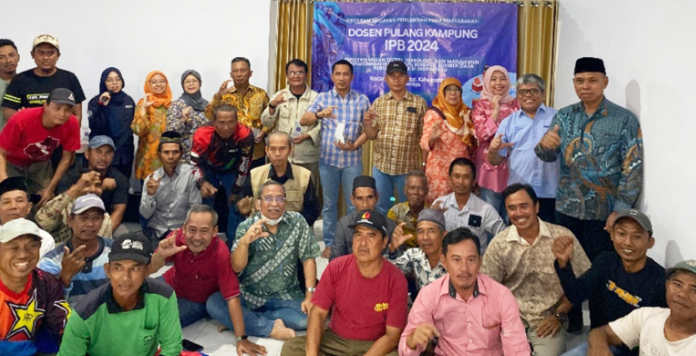
- IPB University introduces innovation in appropriate incinerator technology as a solution for waste processing at ports
A team of lecturers from the Department of Fisheries Resource Utilization (PSP) at IPB University introduced an appropriate incinerator technology innovation as a sustainable solution for waste management at fishing ports, specifically targeting the stakeholders of the Tanjung Luar Fisheries in West Nusa Tenggara (NTB). This initiative was part of the Dosen Pulang Kampung (Dospulkam) or Lecturer Homecoming program and took place in August 2024 at the Tanjung Luar Fishing Port. The program involved multiple stakeholders, including local fishing groups, fish logistics operators, port managers, youth community organizations, and small and medium enterprises (SMEs) operating in the port area.
In addition to introducing the waste treatment technology, the activity also included a review of environmentally friendly fisheries and logistics operations and an environmental control assessment with solid waste analysis at the port. Led by Mustaruddin, the program emphasized that environmental management in fishing ports is essential to maintaining the quality of fish, reducing waste-handling costs, and preventing pollution resulting from fisheries logistics activities.
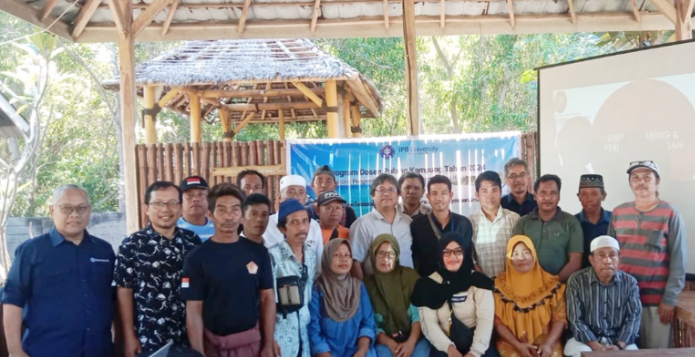
Water sensitive waste disposal
IPB University has established comprehensive water quality standards and discharge guidelines that are fully aligned with Indonesia’s key national environmental regulations. These include Government Regulation No. 82/2001 on Water Quality Management and Water Pollution Control, which provides the legal foundation for maintaining water quality, and Minister of Environment Regulation No. 5/2014 on Wastewater Quality Standards, which defines the national parameters and maximum allowable limits for wastewater discharge.
In addition, the university adheres to the Minister of Environment and Forestry Regulation No. P.68/MENLHK/SETJEN/KUM.1/8/2016 on Domestic Wastewater Management, which directly governs campus operational activities, and Government Regulation No. 22/2021 on Environmental Protection and Management, which emphasizes the importance of maintaining high water quality standards. All these regulatory frameworks are integrated into IPB University’s Green Campus Policy and implemented through its Standard Operating Procedure (SOP) for Wastewater Management (IPAL). This policy framework—rooted in both national regulations and international best practices—positions IPB University as a leader in sustainable campus and environmental management.
In addition, IPB University adheres to the Minister of Environment and Forestry Regulation No. P.68/MENLHK/SETJEN/KUM.1/8/2016 on Domestic Wastewater Management, which applies directly to campus operations. The implementation is also aligned with Government Regulation No. 22/2021 on Environmental Protection and Management, which emphasizes the importance of maintaining water quality and proper wastewater treatment.
To ensure scientific accuracy and reliability in monitoring water quality, IPB University applies the ISO 17025-2017 standard in its laboratories, including those in the Department of Agroindustrial Technology, Faculty of Agricultural Engineering and Technology, the PROLING Laboratory in the Faculty of Fisheries and Marine Sciences, and also The Environmental Laboratory of the Center for Environmental Research (PPLH) IPB University. This reflects the university’s strong commitment to evidence-based and credible water management practices.
Furthermore, IPB University operates a Wastewater Treatment Plant (WWTP) that uses modern biotechnology systems to process and neutralize biological and chemical waste from campus facilities. The treated water meets national safety standards for environmental discharge. The university also complies with the Minister of Environment and Forestry Regulation No. P.16/MENLHK/SETJEN/KUM.1/4/2019 on Water Quality Standards and Wastewater Discharge Guidelines.
Through this comprehensive regulatory and operational framework, IPB University demonstrates its institutional dedication to safeguarding aquatic ecosystems, protecting biodiversity, and promoting human health and well-being.
Moreover, IPB has an Academic Paper of Planning of Green Campus Implementation 2019 – 2023 also describes guidelines to the compliance of all national and international water quality standards as stipulated at Chapter 4 – Sub-Chapter 4.1, Chapter 5.8, and Chapter 6.7
IPB’s water quality standards and guidelines for water discharge
IPB University has developed a comprehensive and well-structured action plan to reduce plastic waste on campus, reflecting its deep institutional commitment to sustainability and environmental protection. This initiative began in 2019 with the issuance of several official circular letters targeting the reduction of plastic, paper, and Styrofoam waste—such as the Circular Letter on Reducing Plastic Waste (No. 10536/IT3/PP/2019) and the Circular Letter on Reducing Paper Waste (No. 17960/IT3/TU/2019).
The commitment was further strengthened in 2021 through :
- Healthy and Sustainable Lifestyle to prevent waste in sea and river in Circular Letter No. 24714/IT3/HM/M/2021 (Page 5 ; Point 3-ii)
- Waste Management, which specifically addressed actions to prevent river and marine pollution originating from land-based activities in Circular Letter No. 22015/IT3/KP/2021 (Page 8 ; Point 5 – 7)
This waste reduction strategy is an integral part of the university’s Green Campus Movement, as outlined in the Academic Paper on Green Campus Planning and Implementation (Page 82) and reinforced by Rector’s Decree No. 133/IT3/LK/2020 on IPB University’s Commitment to achieving the Sustainable Development Goals (action to Reducing Plastic Waste, Page). The decree emphasizes the adoption of reuse and recycle principles, the implementation of responsible hazardous waste management, and the reduction of plastic pollution in both terrestrial and aquatic environments.
The Green Campus Movement
The Green Campus Movement is implemented through five key collaborative programs: (1) Healthy Canteen Ecolabelling, (2) Go-Teco – Procurement of Tumblers and Ecobags, (3) Plastic Elimination Policy on Campus, (4) Standardization of Trash Cans, and (5) Thematic Day (#HayuAtuh Movement). These programs aim to foster a behavioral shift toward a cleaner, plastic-free university environment.
To further strengthen its implementation, IPB University partnered with Mountrash in 2021 to establish a digital-based plastic waste collection system and installed 30 vending waste machines in 2023 to encourage responsible waste segregation and recycling. The PKSPL-IPB Unit also introduced an SOP on Hygiene Procedures and Restriction of Plastic Use, providing detailed operational guidance to minimize plastic consumption during academic, administrative, and research activities. Complementing these initiatives, the Office of Risk Management and Occupational Environmental Protection issued the Implementation Guidelines for the Management of Household-Type Waste within the IPB University Work Environment, further institutionalizing standardized waste management practices across all university units.
In terms of technological innovation, since 2020 IPB University has operated an eco-incinerator to process plastic and Styrofoam waste and developed a plastic to paving block recycling system, which has been extended to local communities through training and outreach programs. These efforts illustrate IPB University’s proactive approach to integrating education, research, and community engagement into sustainable waste management.

Figure 1. IPB waste vending machine

Figure 2. Eco incinerator in IPB University campus
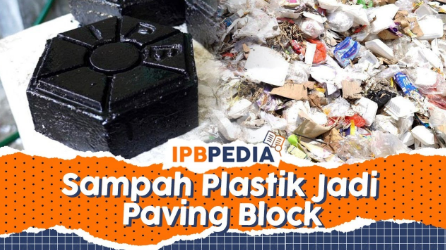
Figure 3. Paving Block from Plastic Waste as IPB’s University Innovation
In 2024, IPB University further expanded its campaign-oriented programs to strengthen public awareness and community participation in reducing plastic waste. One of the flagship initiatives was the Workshop “Youth Agricareture (YACT): Turning Plastic Waste into Economically Valuable Crafts”, organized by the International Association of Students in Agricultural and Related Sciences (IAAS) Local Committee IPB University on October 8, 2024. The event, themed “Eco-Craft: From Trash to Art for a Greener Future,” promoted environmental awareness and creativity by transforming plastic waste into useful and artistic crafts. The program also extended its outreach through YACT Goes to School (YGTS)—held at SMAN 1 Dramaga and attended by 40 students from the school’s Scientific Club—and YACT Goes to Village (YGTV), which encouraged youth engagement in sustainable waste practices at the community level.
Additionally, student innovators under the “KKNT Inovasi” program (August 8, 2024) developed a practical solution for plastic waste management by creating ecobrick paving blocks made from recycled plastic, used oil, and sand in Banjaragung Village, Tegal. This innovation exemplifies the university’s hands-on approach to integrating academic learning with real-world sustainability actions, promoting circular economy principles, and empowering local communities to address plastic waste challenges effectively.
Through its policy framework, technological innovations, and student-led initiatives, IPB University demonstrates a systematic, participatory, and measurable action plan to reduce plastic waste on campus. These integrated efforts reinforce IPB University’s leadership in sustainable campus management and its ongoing contribution to achieving the Sustainable Development Goals (SDGs), particularly in responsible consumption, clean water, and ecosystem protection.
Policy on Preventing and Reducing Marine Pollution
IPB University has established a strong and comprehensive policy framework to prevent and reduce marine pollution, particularly that originating from land-based activities. This institutional commitment is anchored in Rector’s Decree No. 133/IT3/LK/2020 (Page 4 Point L), which explicitly mandates the protection of aquatic ecosystems—including rivers, coastal zones, seagrass beds, coral reefs, and mangrove forests—through sustainable policies, research, and community engagement. This framework reinforces IPB University’s commitment to achieving the Sustainable Development Goals (SDGs), especially Goal 14 (Life Below Water), by promoting responsible waste management and pollution prevention.
The IPB university’s marine pollution prevention policy builds upon earlier initiatives outlined in the Academic Paper of Green Campus Planning 2019–2023 , which introduced long-term strategies to minimize the impact of land-based waste on marine environments. These include institutional appeals to reduce the use of plastic bags, bottled water, Styrofoam, and paper, all of which significantly contribute to marine debris. To operationalize these principles, IPB University issued two major circular letters—Circular Letter No. 24714/IT3/HM/M/2021 on Healthy and Sustainable Lifestyles (Page 7; Point 3-ii) and Circular Letter No. 22015/IT3/KP/2021 on Waste Management—that outline practical measures to prevent waste leakage into rivers and seas (Page 11; Point 5 -7).
At the operational level, IPB’s policy implementation extends through departments and research centers such as the Center for Coastal and Marine Resources Studies (CCMRS-IPB), which enforces Hygiene Procedures and Restrictions on the Use of Plastics as part of its standard working protocol. Furthermore, IPB’s long-standing advocacy has influenced broader environmental governance; since 2018, its faculty and students have worked with the Bogor City Government to support a local regulation banning single-use plastics, demonstrating the university’s real-world policy impact beyond campus boundaries.
In 2024, IPB University continued translating its policies into action through community-based clean-up initiatives. The Student Association of Aquatic Resource Management (Himasper) organized the Ciliwung Care Day 2024 in Kedung Halang, Bogor, collecting 450 kilograms of waste, mostly single-use plastics, in collaboration with the Ciliwung Care Community (KPC), Bogor City Environmental Agency, and Regional Disaster Management Agency (BPBD). Similarly, students from the KKNT Innovation Program conducted a Beach Clean-Up at Palangpang Beach, Ciletuh Geopark, Sukabumi Regency, during the 67th Fishermen’s Day celebration. The activity involved local residents and tourists in removing plastic and organic waste carried from rivers to the coast, followed by an educational outreach program called Bina Cinta Laut (“Fostering Love for the Sea”), which raised awareness about responsible waste management.
Through its regulations, institutional guidelines, and on-ground community engagement, IPB University demonstrates a comprehensive and action-oriented policy to prevent and reduce marine pollution of all kinds—particularly from land-based sources—thereby reinforcing its leadership in marine sustainability and environmental stewardship.

Figure 1. the Ciliwung Care Day 2024 in Kedung Halang

Figure 2. Beach Clean-Up by IPB University’s KKNT Innovation Students at Ciletuh Geopark
Maintaining a local ecosystem
Minimizing alteration of aquatic ecosystems
Since 2019, IPB has a plan to minimize physical, chemical and/or biological alteration of related aquatic ecosystems. This plan are integrated in Green Campus Initiatives movement and was mentioned in Green Campus Academic Paper. Minimizing Alteration of Aquatic Ecosystem especially mentioned in Chapter 4, Sub-Chapter 4.3. (Page 51); Chapter 5.4 (Page 77) & Chapter 6.3 (Page 112). The Green Campus Team of IPB University is an ongoing and forthcoming study in the campus’ existing operational activities to be annually held in compliance with current regulations in Indonesia.
It is implemented based on the Standard Operational Procedures on Hazardous Waste Treatment supervised by the Directorate of General Affairs.
Wastewater Disposal Standard to Minimize Alteration of Aquatic Ecosystem
IPB University has fulfilled wastewater disposal standard based on ISO/IEC 17025 (General requirements for the competence of testing & calibration laboratories). Several laboratories of IPB have received ISO/IEC 17025 certification.

IPB plan to minimize alteration of aquatic ecosystems
IPB University has monitor the health of aquatic ecosystems through several activities:
PPLH IPB University Monitors River Ecosystem in Jakarta
Since 2018, IPB University, through its Center for Environmental Studies (Pusat Penelitian Lingkungan Hidup – PPLH), has been actively engaged in monitoring the health of aquatic ecosystems in partnership with the DKI Jakarta Environmental Agency (DLH). This long-term river monitoring program is conducted quarterly to capture variations in water quality across different hydrological conditions — including the dry season, rainy season, and transitional periods between them. From 2018 to 2023, the program has continuously improved in both scope and data quality, with monitoring points expanded from 90 in 2018 to 111 in 2019, and to 120 between 2021 and 2023. This expansion ensures more accurate and representative assessments of river ecosystem health throughout Jakarta.
In January 2024, DLH DKI Jakarta reaffirmed its collaboration with PPLH IPB University through a new initiative to strengthen environmental monitoring for the coming year. This ongoing partnership demonstrates that IPB University, as an institution, plays an active and sustained role in monitoring and safeguarding aquatic ecosystems by conducting systematic field measurements, water sampling, laboratory analyses, and comprehensive environmental quality assessments in collaboration with government agencies.
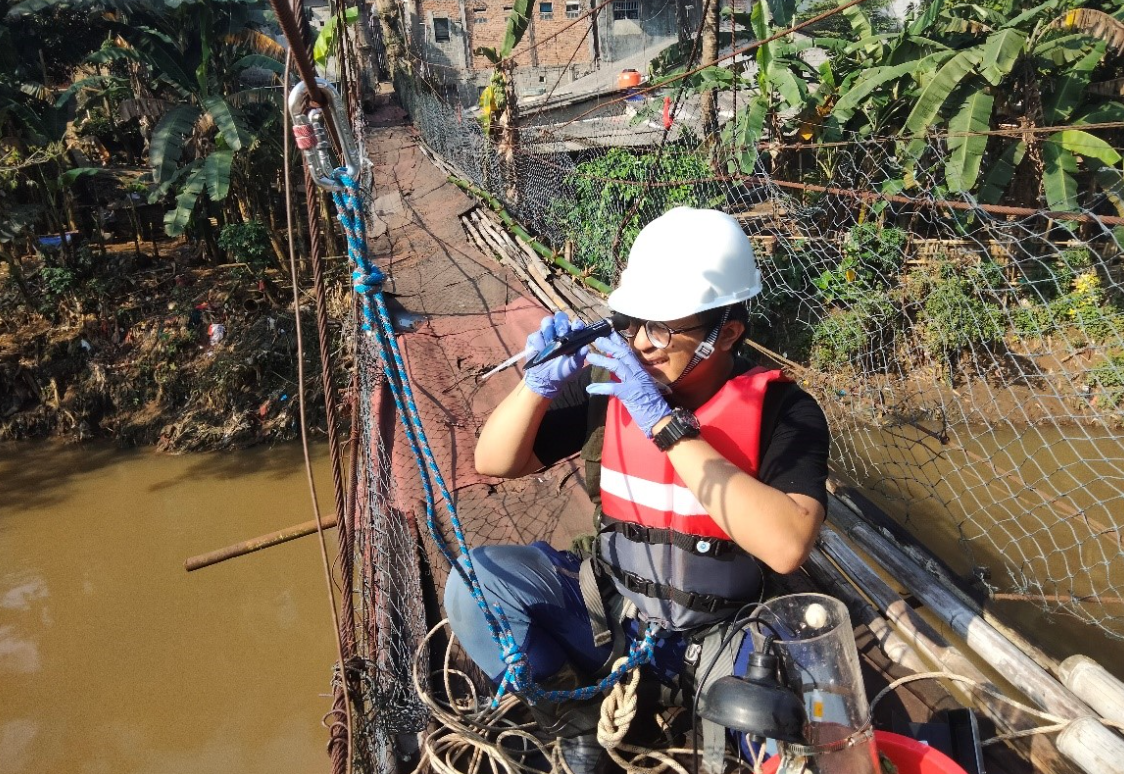
Figure 1. River monitoring activities
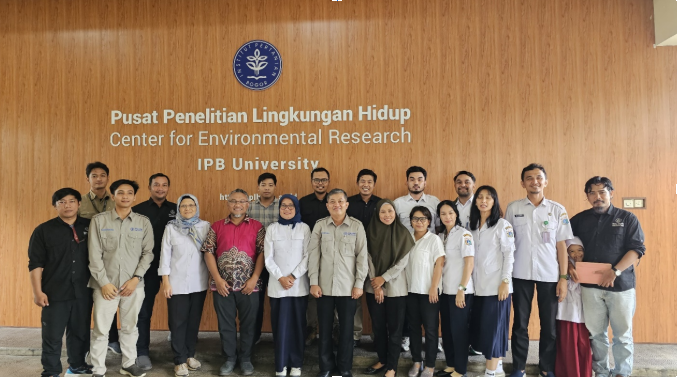
Figure 2. IPB’s Center for Environmental Research and the DKI Jakarta Environmental Agency continue their multi-year river and lake water-quality monitoring collaboration
IPB Experts Conducted Environmental DNA Biomonitoring in Ciliwung River, Indonesia
In 2024, IPB researchers through Prof. Hefni and Team monitored the Lower Ciliwung River using environmental DNA (eDNA). From 9 water samples at 3 sites they generated ~1.49 million reads, detecting 22–28 taxonomic classes per site. Communities were dominated by Coscinodiscophyceae (38.3%), with insects (13.8%), rotifers (10.8%), mammals (9.64%), green microalgae (7.27%), and polychaetes (4.52%) also present. eDNA revealed fish, plankton, benthos, bacteria, and even terrestrial/flying vertebrates. Biodiversity was moderate with high dominance, community composition differed significantly among sites (ANOSIM-R = 0.43, p < 0.05), many taxa were pollution-tolerant, and diversity declined downstream.

Figure 3. Three eDNA freshwater sample collection sites across the Lower Ciliwung River: (1) East Jakarta; (2) Central Jakarta; and (3) North Jakarta.
In 2024, IPB University demonstrated a strong institutional commitment to promoting good aquatic stewardship through a series of structured programs, financial incentives, and educational initiatives targeting both coastal and inland water ecosystems.
A flagship initiative was the Dosen Pulang Kampung (Dospulkam) 2024 program, implemented in more than 75 villages across Indonesia. This IPB university-funded community service scheme enabled IPB lecturers to directly engage with local stakeholders, share sustainable aquaculture innovations, and strengthen ecosystem-based management practices.
IPB University lecturers held community training in Desa Bontosunggu – Selayar
IPB University lecturers from the Department of Aquaculture, Faculty of Fisheries and Marine Science led by Dr. Apriana Vinasyiam held a community training in Desa Bontosunggu, Bontoharu, Kepulauan Selayar under IPB’s institutional “Dosen Pulang Kampung” (DPK) program. The activity was held on 8–9 August 2024. The training theme—“Integrating Human Resource Development and Appropriate, Integrated Marine Aquaculture Technology”—focused on building local capacity for responsible marine organism farming and transferring practical aquaculture know-how to coastal stakeholders. The initiative was conducted with and welcomed by the Selayar local government, represented by the Regional Secretary Drs. Mesdiyono, underscoring formal local partnership and on-site facilitation.
IPB’s Community Empowerment Program in Mulyaharja: Strengthening Science-Based Fisheries Stewardship
IPB University—through the Study Program of Aquaculture Hatchery Technology and Management, School of Vocational Studies ran a community service (PPM) program in Kelurahan Mulyaharja, Bogor to map local aquaculture potential and deliver practical, sustainable solutions for fish farmers. The activity was held on 29 May 2024. The team of nine lecturers worked with the village government and farmer groups (include KWT), held FGDs, and conducted on-site water-quality checks, soil sampling, and disease diagnostics to guide follow-up recommendations and pilot models. Local leaders—the Lurah of Mulyaharja and agricultural extension officers—endorsed and participated in the activities, while IPB framed the program as Tri Dharma fulfillment and research-to-practice “hilirisasi” with MBKM opportunities that incentivize ongoing student–community engagement.
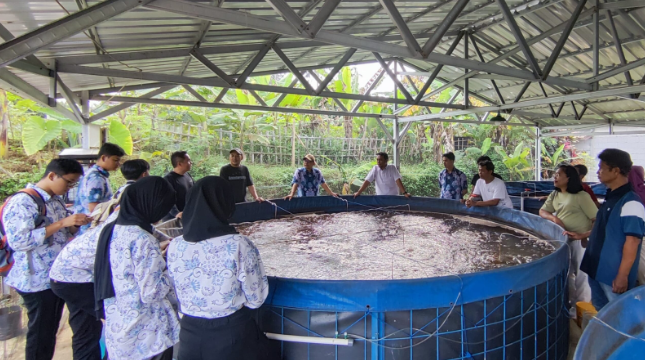
IPB Student association monitoring mangrove area in Desa Mundu, Cirebon
IPB University—through The Marine Science and Technology Student Association of the Faculty of Fisheries and Marine Sciences (HIMITEKA)—conducted the first post-planting monitoring of the KONSURV 2024 mangrove restoration on 31 October 2024, in Mundu Village, Cirebon, West Java. This Activity in collaboration with local stakeholders including the Mundu Mangrove Community. The monitoring assessed seedling survival and guided follow-up maintenance, while also organizing a coastal clean-up to reduce added pressure from trash accumulating at the river estuary. The team recorded 763 dead seedlings, largely due to prolonged submersion and large waves, and immediately replanted 200 seedlings using an improved technique—one stake supporting two propagules—to enhance stability and survival. Looking ahead, the team scheduled further replanting in March 2025 and plans to improve the quality of planting stakes to strengthen mangrove resilience.
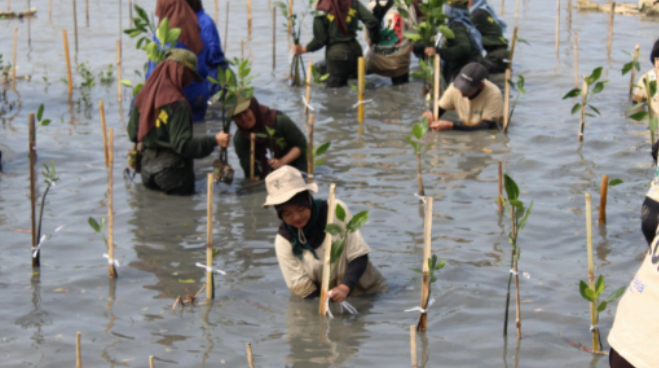
IPB actively collaborated with the local community to maintain shared aquatic ecosystems, amongst activities :
Center for Coastal and Marine Resources Studies collaborated with local the Poto Tano Village Tourism Management Group
IPB University, through the Center for Coastal and Marine Resources Studies (CCMRS), played a key institutional role in establishing a five-year conservation partnership for the Gili Balu Marine Tourism Park (TWP) in West Sumbawa, West Nusa Tenggara. The collaboration brought together the Regional Public Service Agency of the Technical Implementation Unit of the Agency for Marine Resources and Fisheries Management Sumbawa–Sumbawa Barat, acting as the official area manager, and the Poto Tano Village Tourism Management Group, representing the local community. The agreement was designed to integrate community-based marine tourism with formal conservation governance to ensure the sustainable management of this shared marine ecosystem. To strengthen coordination, PKSPL deployed two field officers on-site in February 2024 to provide continuous technical assistance and monitoring. The initiative is part of Transformasea, an ecosystem-based marine ecotourism program supported by PT Amman Mineral Nusa Tenggara and the West Nusa Tenggara Marine and Fisheries Office, aiming to align economic development with marine conservation.
Center for Coastal and Marine Resources Studies partnership with the Tanggamus Regency Government to implement a blue-economy program
The Center for Coastal and Marine Resources Studies (CCMRS) at IPB University has formalized a partnership with the Tanggamus Regency Government (Lampung) to implement a blue-economy program along the regency’s 202-kilometer coastline. The meeting took place on January 23 at IPB’s Baranangsiang Campus. Under this collaboration, the parties agreed to develop a blue-economy action plan for Tanggamus Coastal Development Movement. The plan covers the sustainable and inclusive management of capture fisheries, aquaculture, tourism, ports, energy, and conservation. The aim is to unlock coastal potential and reduce disparities between coastal and inland areas while safeguarding shared aquatic ecosystems. Implementation will proceed through joint planning and technical assistance by CCMRS, leveraging IPB’s expertise and long-standing field programs (e.g., IPB’s student community service/KKN) to guide local government and communities.

Graduate students from IPB University’s Tropical Ocean Economics Planted 500 mangrove seedlings in Tidung Kecil Island
Graduate students from IPB University’s Graduate Program in Tropical Marine Economics visited Tidung Kecil Island in the Thousand Islands on 19 January 2024. As part of efforts to protect the island’s aquatic ecosystem, they planted 500 Rhizophora mangrove seedlings to help safeguard the Thousand Islands’ coastline. The Program led by Dr. Kastana Sapanli and carried out with the Kamar Ijo Community and the Jakarta Provincial Food Security, Marine, and Agriculture Agency staff. The Staff guided the students on site, including group planting using polybags adapted to the area’s sandy substrate and strong currents.

IPB University has implemented a watershed management strategy through the Dosen Pulang Kampung (Dospulkam) program, an example :
IPB University’s Expert Implemented Watershed and Aquatic Biodiversity Management in Lake Toba
A team of experts from IPB University’s Faculty of Fisheries and Marine Sciences, through the Dosen Pulang Kampung (Dospulkam) program, conducted research from April to October 2024. The team consisted of Prof. Jonson Lumban-Gaol, Dr. Charles P. H. Simanjuntak, Prof. Vincentius V. Siregar, and Dr. Dinar Tri Soelistyowati. The IPB University expert team carried out community and environmental interventions in the watershed area (DAS) of Lake Toba, specifically in Huta Paung Village, Pollung Sub-district, Humbang Hasundutan Regency. The program utilized satellite remote sensing (inderaja satelit) technology to map land use, define management boundaries for kemenyan (benzoin) plantations, and monitor the water and environmental conditions of the lake. This location-specific spatial mapping provides a foundation for understanding how land use around the watershed interacts with the aquatic system, supports the rights of local farmers, and enables continuous environmental monitoring.
Subsequently, in October 2024, the team conducted a survey on the invasive fish species Red Devil fish (Amphilophus citrinellus) across several regencies within the Lake Toba watershed. They documented the dominance of this invasive species, the presence of native fish species (such as Neolissochilus soro, Glossogobius giuris, and Mystacoleucus padangensis), and began designing interventions for species control, inter-species interactions, and community-based utilization.
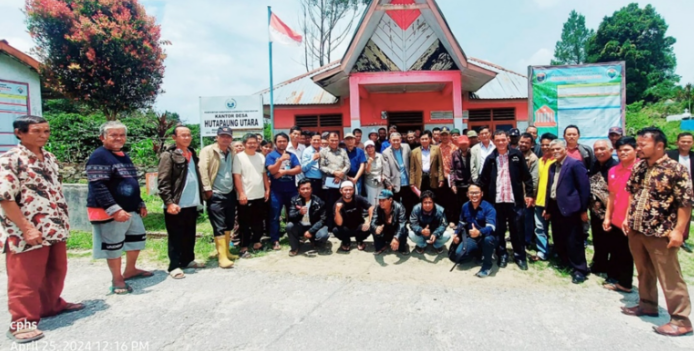
Figure 1. IPB Expert Team with Communities Around Lake Toba
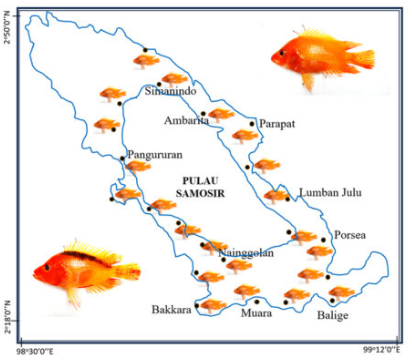
Figure 2. Distribution of the invasive fish species Red Devil Fish
RELATED NEWS
It seems we can't find what you're looking for.

